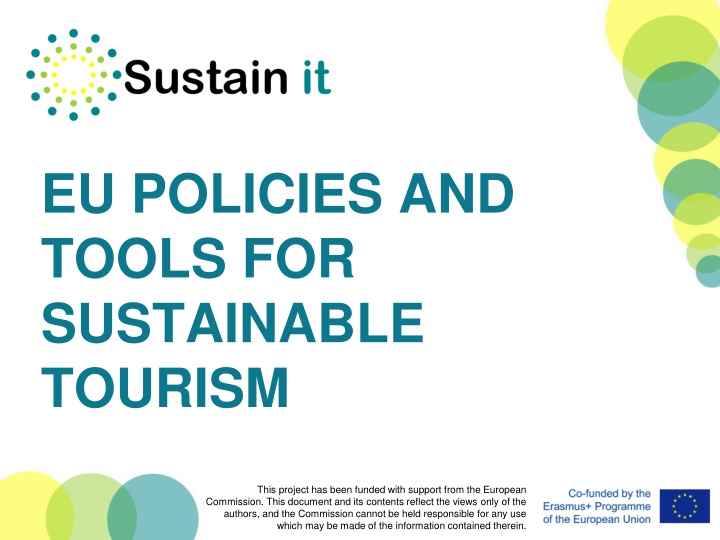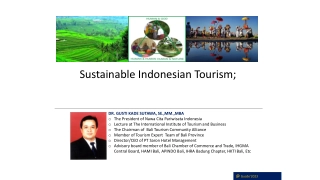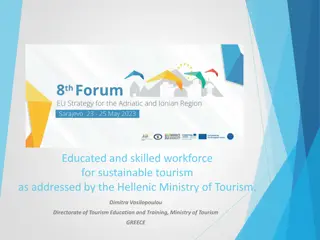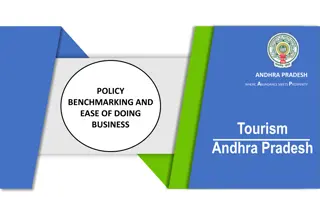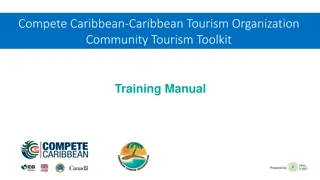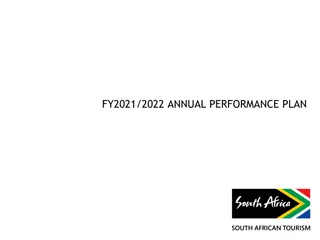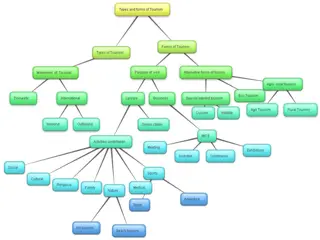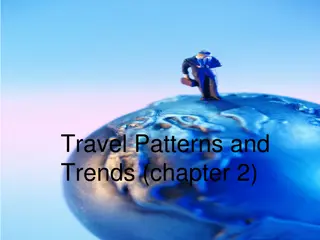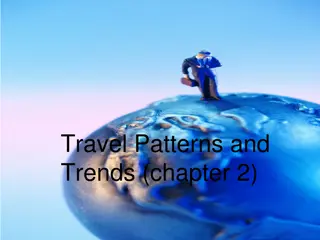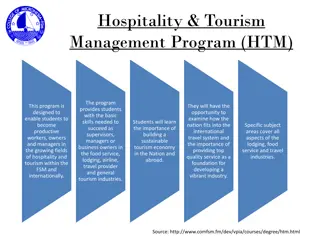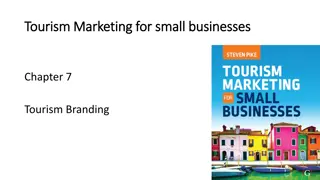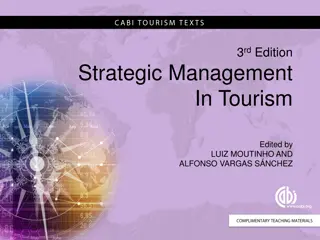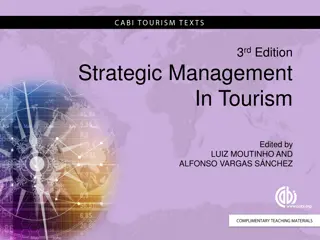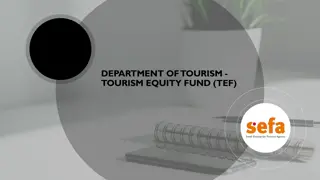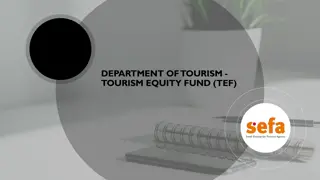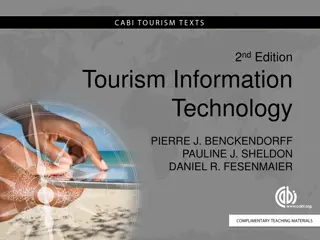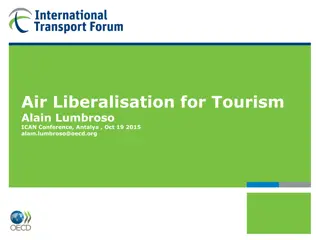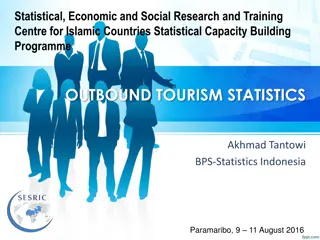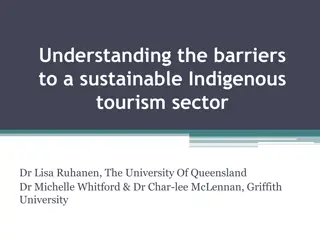EU Policies and Tools for Sustainable Tourism Overview
This project funded by the European Commission focuses on the EU agenda for sustainable and competitive European tourism, outlining objectives, challenges, and solutions to promote economic prosperity, social equity, environmental protection, and cultural preservation within the tourism sector.
Download Presentation

Please find below an Image/Link to download the presentation.
The content on the website is provided AS IS for your information and personal use only. It may not be sold, licensed, or shared on other websites without obtaining consent from the author.If you encounter any issues during the download, it is possible that the publisher has removed the file from their server.
You are allowed to download the files provided on this website for personal or commercial use, subject to the condition that they are used lawfully. All files are the property of their respective owners.
The content on the website is provided AS IS for your information and personal use only. It may not be sold, licensed, or shared on other websites without obtaining consent from the author.
E N D
Presentation Transcript
EU POLICIES AND TOOLS FOR SUSTAINABLE TOURISM This project has been funded with support from the European Commission. This document and its contents reflect the views only of the authors, and the Commission cannot be held responsible for any use which may be made of the information contained therein.
OVERVIEW EU Agenda for sustainable and Unit competitive European tourism 1. Unit 2. EU Guidebook on Sustainable Tourism for Development Unit 3. EU tools and support systems for sustainable tourism This project has been funded with support from the European Commission. This document and its contents reflect the views only of the authors, and the Commission cannot be held responsible for any use which may be made of the information contained therein.
Unit 1. EU European tourism Agenda for sustainable and competitive
WHAT IS IT? The EU agenda for a sustainable and competitive European tourism is a Commission Communication which proposes solutions to the challenges of sustainable tourism. This Communication is the official endorsement and launching of a medium-long term Agenda in which all stakeholders should undertake the necessary steps to strengthen the contribution of sustainable practices to facilitate the competitiveness of Europe as the most attractive tourism destination. This project has been funded with support from the European Commission. This document and its contents reflect the views only of the authors, and the Commission cannot be held responsible for any use which may be made of the information contained therein.
MAIN OBJECTIVES The main objectives the Agenda wants to achieve are: deliver economic prosperity deliver social equity and cohesion deliver environmental protection deliver cultural protection This project has been funded with support from the European Commission. This document and its contents reflect the views only of the authors, and the Commission cannot be held responsible for any use which may be made of the information contained therein.
CHALLENGES 1/2 In the Agenda are set out the major challenges the tourism sector will have to deal with: preserving natural and cultural resources limiting negative impacts at tourist destinations, including the use of natural resources and waste production This project has been funded with support from the European Commission. This document and its contents reflect the views only of the authors, and the Commission cannot be held responsible for any use which may be made of the information contained therein.
CHALLENGES 2/2 promoting the wellbeing of the local community reducing the seasonality of demand limiting the environmental impact of tourism-related transport making tourism accessible to all improving the quality of tourism jobs This project has been funded with support from the European Commission. This document and its contents reflect the views only of the authors, and the Commission cannot be held responsible for any use which may be made of the information contained therein.
PRINCIPLES 1/2 To address the challenges of the Agenda these principles must be followed: taking a holistic, integrated approach planning for the long term adopting an appropriate pace of development involving all stakeholders This project has been funded with support from the European Commission. This document and its contents reflect the views only of the authors, and the Commission cannot be held responsible for any use which may be made of the information contained therein.
PRINCIPLES 2/2 using the best available knowledge minimising and managing risk reflecting impacts in costs setting and respecting limits practising continuous monitoring This project has been funded with support from the European Commission. This document and its contents reflect the views only of the authors, and the Commission cannot be held responsible for any use which may be made of the information contained therein.
Unit 2. EU Development Guidebook on Sustainable Tourism for
WHAT IS IT? The EU Guidebook on Sustainable Tourism for Development is a tool developed by the European Commission which enhances the understanding of tourism and describes how the sector relates to the EU Agenda for Change. The Guidebook takes a comprehensive approach to tourism, covering a wide range of topics relating to its planning, development, management and impact. This project has been funded with support from the European Commission. This document and its contents reflect the views only of the authors, and the Commission cannot be held responsible for any use which may be made of the information contained therein.
MAIN OBJECTIVE The main objective the Guidebook wants to achieve is to mainstream tourism across European Countries This project has been funded with support from the European Commission. This document and its contents reflect the views only of the authors, and the Commission cannot be held responsible for any use which may be made of the information contained therein.
HOW To reach that goal the Guidebook wants to: provide guidance to assess the tourism sector s importance identify opportunities for sustainable tourism development plan actions that both EU Services in Brussels and the EU Delegations in 180 countries can include in their programme cycles This project has been funded with support from the European Commission. This document and its contents reflect the views only of the authors, and the Commission cannot be held responsible for any use which may be made of the information contained therein.
STRUCTURE 1/4 The Guidebook is organised in 3 parts: Part 1: GUIDANCE NOTE Part 2: METHODOLOGY Part 3: SITUATION ANALYSIS This project has been funded with support from the European Commission. This document and its contents reflect the views only of the authors, and the Commission cannot be held responsible for any use which may be made of the information contained therein.
STRUCTURE 2/4 Part 1: GUIDANCE NOTE It summarises key aspects of tourism in developing countries and presents the essential principles of sustainable tourism. This part explains how the EU s policy framework, such as the Consensus for Development, can relate to the various aspects of tourism. This project has been funded with support from the European Commission. This document and its contents reflect the views only of the authors, and the Commission cannot be held responsible for any use which may be made of the information contained therein.
STRUCTURE 3/4 Part 2: METHODOLOGY The methodology of the guidebook takes 5 pillars into consideration and it discusses in detail a number of issues, themes, challenges and opportunities, leading to a set of questions to assess whether and how they are being addressed. This project has been funded with support from the European Commission. This document and its contents reflect the views only of the authors, and the Commission cannot be held responsible for any use which may be made of the information contained therein.
STRUCTURE 4/4 Part 3: SITUATION ANALYSIS The situation analysis provides data and evidence (statistics, trends, exports, etc.) on tourism and its relationship to development, defining as well challenges related to measuring the socioeconomic impacts. It covers issues pertaining to financing tourism for development. This project has been funded with support from the European Commission. This document and its contents reflect the views only of the authors, and the Commission cannot be held responsible for any use which may be made of the information contained therein.
Unit 3. EU tools and support systems for sustainable tourism
WHICH ARE THEY? The EU tools and support systems for sustainable tourism are two: ETIS : a toolkit regarding the European Tourism Indicator System 1. for Sustainable Destinations QUALITEST : a manual for Evaluating the Quality Performance of 2. Tourist Destinations and Services This project has been funded with support from the European Commission. This document and its contents reflect the views only of the authors, and the Commission cannot be held responsible for any use which may be made of the information contained therein.
1. ETIS: what is it? ETIS is a toolkit regarding the European tourism indicator system for sustainable destinations, it is a management, monitoring and information tool specifically aimed to tourist destinations, encouraging them to adopt a more intelligent approach to tourism planning. This project has been funded with support from the European Commission. This document and its contents reflect the views only of the authors, and the Commission cannot be held responsible for any use which may be made of the information contained therein.
1. ETIS: main objective Its main objective is to contribute to improve the sustainable management of the tourist destinations: it wants to help people interested to measure their processes for sustainable management in order to monitoring results and progress over time. This project has been funded with support from the European Commission. This document and its contents reflect the views only of the authors, and the Commission cannot be held responsible for any use which may be made of the information contained therein.
1. ETIS: Indicators There are two types of indicators: a) Core indicators: they cover the fundamental aspects of sustainability monitoring and provide the basis for effective destination management. b) Supplementary indicators: they add to the basic information provided and allow destinations to tailor the system to their own particular needs or destination category (e.g. mountain, city, rural, etc.) This project has been funded with support from the European Commission. This document and its contents reflect the views only of the authors, and the Commission cannot be held responsible for any use which may be made of the information contained therein.
2. QUALITEST: what is it? QUALITEST is a manual for evaluating the quality performance of tourist destinations and services. The Manual supports to understand exactly where the destinations are positioned, regarding the quality performance and it can help improve the quality performance, if actions are taken in the right fields. This project has been funded with support from the European Commission. This document and its contents reflect the views only of the authors, and the Commission cannot be held responsible for any use which may be made of the information contained therein.
2. QUALITEST: main objectives The main objectives of the QUALITEST Manual are to offer a tourist destination the chance: to measure, benchmark and monitor its own quality performance to increase the level of satisfaction of tourists to increase the level of satisfaction of local tourism industry to increase the local people s quality of life to increase the environmental quality This project has been funded with support from the European Commission. This document and its contents reflect the views only of the authors, and the Commission cannot be held responsible for any use which may be made of the information contained therein.
2. QUALITEST: Indicators The QUALITEST tool is divided into 16 core indicators, grouped into two categories: a) quality of destination b) quality of tourist product Each core indicator consists of three sub-indicators based on the: i. perceived quality ii. quality management iii. quality performance This project has been funded with support from the European Commission. This document and its contents reflect the views only of the authors, and the Commission cannot be held responsible for any use which may be made of the information contained therein.
Thank you for your attention www.sustainit.eu
